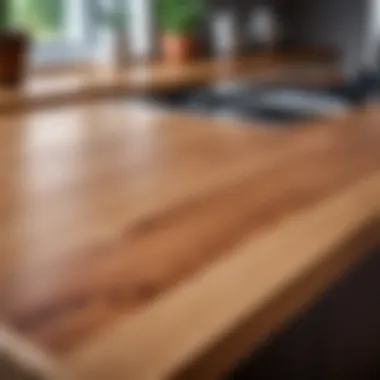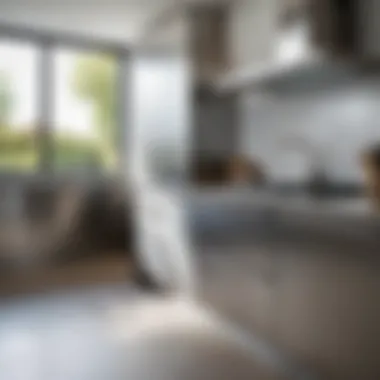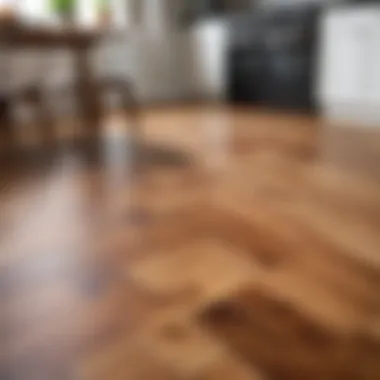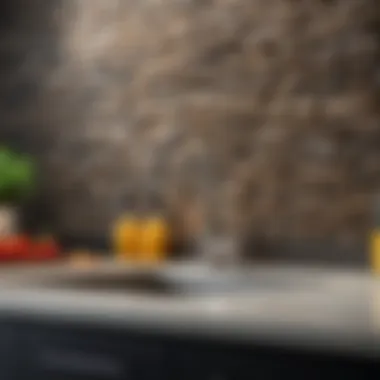Choosing the Best Materials for Your Kitchen


Intro
The selection of materials for kitchen applications embodies a significant decision-making process. The kitchen serves as one of the most dynamic areas in a home, facing frequent use and the unique challenges of daily cooking and cleaning. Each material available comes with its own set of advantages and drawbacks that can affect the overall look, functionality, and durability of your kitchen space. This discussion will guide readers through various materials, including wood, stainless steel, laminate, and more. We will emphasize their strengths and weaknesses, enabling homeowners and DIY enthusiasts to choose wisely based on their project needs.
Проектирование и планирование
Before diving into the world of materials, careful planning and design are essential. Understanding your kitchen layout and the specific requirements of your project can provide a solid foundation for your choices.
Как выбрать проект для DIY
Selecting the right project is crucial. Whether you are renovating an entire kitchen or making small upgrades, your choices should reflect both functionality and aesthetic appeal. Assess your current kitchen setup. Ask yourself: What are the pain points? Do you need more storage? Would better surface materials enhance your cooking experience? Take the time to research various design inspirations. Journals, online platforms, or even visits to local showrooms can help clarify the possibilities.
Оценка времени и ресурсов
Consider the resources at your disposal. Some materials require extensive installation time, while others may allow for a faster turnaround. It is vital to evaluate your available time for the project and the tools required. If it is a DIY project, be realistic about your skill level. You also need to assess the overall budget. Often, materials vary greatly in cost, which can affect your final decisions.
Выбор материалов
The choice of materials can define the kitchen's usability and aesthetic. Each material offers a distinct appeal, and understanding their individual characteristics can inform better decisions.
Типы материалов для различных проектов
- Wood: This material brings warmth and elegance to any kitchen. While solid wood can be durable, it often requires care to prevent warping and damage from moisture. Plywood or engineered wood may serve as cost-effective alternatives, offering better resistance to moisture.
- Stainless Steel: Known for its durability and modern aesthetic, stainless steel is perfect for countertops and appliances. It is resistant to heat and stains, though it can scratch easily. Maintenance is key, involving regular cleaning to keep its shine.
- Laminate: An affordable option that allows for a wide range of styles and colors. Its surface is typically easy to clean but may not withstand high heat as effectively as other materials.
- Quartz: Engineered stone that combines durability and aesthetic appeal. Unlike natural stones, quartz is non-porous, making it less prone to staining.
Советы по покупке и экономии
When shopping for materials, prioritize quality over price. Lower costs may initially seem attractive, but they can lead to increased maintenance and replacement costs over time. Always check for samples to assess texture and color against your kitchen design. Comparing prices across various retailers can lead to cost savings.
"Quality materials not only enhance the look of your kitchen but also contribute to its long-term value."
Understanding Kitchen Material Requirements
Selecting the right materials for a kitchen is crucial for both functionality and aesthetics. This section highlights key aspects to consider when choosing materials for kitchen applications. Material selection impacts not only the look of the kitchen but also how it holds up over time and withstands everyday use. Understanding these requirements can guide homeowners, interior designers, and builders in making informed decisions that balance style with practicality.
Functionality and Aesthetics
A kitchen serves multiple functions. It should support food preparation, cooking, and perhaps entertaining. Therefore, it's essential to choose materials that are both functional and aesthetically pleasing. For example, the counter surface must withstand heat and moisture. Choosing materials like quartz or granite provides durability while also offering a variety of colors and patterns to enhance visual appeal. Functionality extends beyond surfaces; consider storage solutions like cabinetry. The materials should facilitate ease of use, aligning with the overall design of the kitchen to create a cohesive look.
Durability Considerations
Durability is on the forefront when selecting kitchen materials. The kitchen is a high-traffic area, exposed to spills, heat, and constant contact. Selecting materials that withstand such demands is vital. For instance, stainless steel is renowned for its strength and resistance to corrosion, making it ideal for appliances or sinks. Solid wood, while beautiful, requires careful consideration regarding its susceptibility to water damage and dents. Understanding the various durability ratings for materials can save you from costly replacements in the future.
Maintenance and Cleaning
Another significant factor is how easy a material is to maintain and clean. Different materials come with different requirements. Laminate surfaces are easy to wipe down and resistant to stains, while natural stone may require sealing to protect against spills. It's essential to match the material choices with your lifestyle. If you prioritize low upkeep, opt for materials with fewer maintenance requirements. Understanding the cleaning agents and methods suitable for each material type is also beneficial. For example, certain surfaces may not tolerate abrasive cleaners, requiring a gentler touch.
"Choosing kitchen materials is not merely a matter of appearance; it is about performance, resilience, and long-term satisfaction."
Common Kitchen Materials
Understanding the various materials available for kitchen applications is vital for achieving both functionality and aesthetics. Each material offers distinct properties that affect durability, maintenance, and overall design.
Choosing the right material can significantly enhance the quality of a kitchen environment. This section highlights popular materials that cater to different needs and styles.
Solid Wood
Types of wood used
Solid wood is a favored choice due to its natural beauty and strength. Common types of wood include oak, maple, and cherry. Each type offers unique grain patterns and colors. Oak, for example, is known for its durability and resistance to wear, making it suitable for high-traffic areas. Maple provides a lighter tone, whereas cherry darkens over time, giving it character.
Pros and cons
The pros of solid wood include its strength and accessibility. It can be easily repaired and refinished. However, the cons are significant. Solid wood is susceptible to warping and requires regular maintenance. It can be more costly compared to other materials.


Best uses in the kitchen
Solid wood is ideal for cabinetry and countertop surfaces. Its aesthetic appeal can enhance the warmth of a kitchen, creating a welcoming atmosphere. However, its absorbent nature can make it less suitable for areas prone to moisture, like sink sides.
Stainless Steel
Properties of stainless steel
Stainless steel is recognized for its high resistance to corrosion and staining. It is an alloy that includes chromium, which enhances its durability. This property makes it a preferred choice for both professional and residential kitchens.
Advantages and disadvantages
Advantages include its durability and low maintenance, making it perfect for busy kitchens. On the downside, it can show fingerprints easily, requiring frequent cleaning. Also, it may not fit well with more traditional designs but excels in modern settings.
Ideal applications
Stainless steel surfaces are excellent for countertops and appliance fronts. They can withstand high temperatures and are non-porous, making them resistant to bacteria. This characteristic is particularly appealing for kitchen hygiene.
Laminate
Characteristics of laminate materials
Laminate is made by fusing layers of material together. This process results in a durable surface that can mimic the look of natural wood or stone at a lower cost. It is available in a variety of colors and patterns, allowing for significant design flexibility.
Benefits and limitations
The benefits of laminate include affordability and ease of installation. Its surface is relatively resistant to scratches and stains. However, it can be prone to chipping, and once damaged, it may be hard to repair. Furthermore, laminate surfaces can be sensitive to high heat, necessitating caution with hot items.
Applications in cabinetry and countertops
Laminate is widely used in cabinetry and as a countertop surface. Its versatility allows it to fit various kitchen styles. Despite its limitations, it can effectively deliver a stylish look without a high cost.
Ceramic Tile
Durability and water resistance
Ceramic tile offers exceptional durability and is water-resistant, making it a prime option for kitchen floors and backsplashes. Its hard surface resists scratches and is easy to clean. This functionality supports the demands of a kitchen environment.
Design flexibility
Ceramic tiles come in various shapes, sizes, and colors. This variety allows homeowners to create unique patterns and visual interest in their kitchen design. The ability to combine different tiles can deliver a personalized look.
Placement considerations
When using ceramic tile, placement is crucial. It works best as flooring or backsplash material. However, heavy items can crack tiles if not installed properly. Thus, ensuring adequate underlayment and support is vital during installation.
Quartz
Engineered stone properties
Quartz surfaces are engineered from natural quartz crystals and resins. This makes them non-porous and resistant to staining. Their durability is paired with a uniform appearance, which many homeowners find appealing.
Maintenance needs
Quartz requires minimal maintenance compared to natural stone. It does not need sealing, which simplifies the cleaning process. Its non-porous nature makes it resistant to bacteria, making it suitable for food preparation areas. However, care is still necessary to avoid exposure to high heat.
Style compatibility
Quartz fits into diverse kitchen styles, from modern to traditional. It can imitate the look of natural stone and offers a wide range of colors and patterns. This versatility allows it to blend seamlessly with various design elements.
Glass
Uses of glass in kitchens
Glass is frequently used in cabinet doors, countertops, or backsplashes. Its reflective properties can make a kitchen appear larger and more open. Additionally, glass can provide an elegant touch to modern designs.


Pros and cons of glass materials
The primary advantages of glass include its aesthetic appeal and easy cleaning. However, it can be fragile and susceptible to scratches. Glass surfaces may require careful handling to avoid breakage. Its installation also typically requires specialized labor.
Design integration
Integrating glass into kitchen design can introduce transparency and lightness. It works well in contemporary kitchens, enhancing overall visual flow. However, the choice of glass design should be consistent with the kitchen's theme to ensure harmony.
Evaluating Material Performance
In the realm of kitchen design, the choice of material transcends mere aesthetics. Evaluating material performance involves understanding how particular materials behave under the unique conditions of a kitchen environment. This assessment is critical. It helps determine not only the longevity of the materials used but also their overall functionality. Key considerations include heat resistance, scratch and stain resistance, and how these factors influence daily use. A kitchen's performance hinges on these elements, making thorough evaluation essential.
Heat Resistance
Heat resistance is a significant factor to analyze when selecting materials for kitchen applications. Kitchens frequently experience temperature fluctuations due to cooking activities. Materials that can withstand high heat without warping or discoloring are preferable.
For instance, countertops made from materials such as granite or quartz exhibit impressive heat resistance. However, some laminates may not withstand high temperatures, leading to potential damage. Consideration of where appliances are situated—is the stove close to the countertop?—is crucial in material selection.
Benefits of assessing heat resistance include:
- Longevity: Materials that endure heat tend to have longer lifespans.
- Safety: Heat-resistant materials can reduce the risk of fire hazards in the kitchen.
- Aesthetic preservation: High heat resistance prevents unsightly damage that detracts from visual appeal.
Scratch and Stain Resistance
Scratch and stain resistance is another vital criterion for evaluating kitchen materials. The kitchen is a high-traffic area, and materials that easily show wear or blemishes can undermine the intended design and functionality.
For example, stainless steel is known for its scratch resistance, making it ideal for appliances and sinks. Conversely, some woods and laminates may be prone to scratching. Regarding stains, materials such as ceramics or quartz surfaces often resist staining better than softer laminates.
Here are significant aspects of scratch and stain resistance:
- Hygiene: Non-porous surfaces are easier to clean, promoting a healthier environment.
- Maintenance: Choosing resistant materials reduces the frequency and intensity of cleaning needed.
- Appearance: Materials that resist scratches and stains maintain their aesthetic much longer, preserving the desired look of the kitchen.
"Material selection based on performance characteristics is a strategic decision that enhances both functionality and longevity."
Sustainability of Kitchen Materials
In recent years, sustainability has become a prominent theme in various industries, including kitchen design and construction. The kitchen, often serving as the heart of the home, presents an opportunity to make environmentally conscious choices. The materials selected for kitchen applications can significantly impact not just aesthetics but also environmental well-being. By prioritizing sustainability, we ensure that the resources used do not degrade the ecosystem for future generations.
Choosing sustainable materials helps reduce waste and decrease reliance on non-renewable resources. Additionally, sustainable options often possess qualities that enhance durability and reduce the frequency of replacements. Homeowners, designers, and builders alike must consider these factors when making material choices for kitchens. The widespread adoption of eco-friendly practices can lead to a healthier environment and promote a culture of sustainability.
Eco-Friendly Options
Sustainable wood alternatives
Sustainable wood alternatives have emerged as an essential focal point in the discourse of green kitchen materials. Bamboo, for example, is one of the most common sustainable wood alternatives. It grows quickly and can reach maturity in just a few years, making it an excellent renewable resource. One remarkable characteristic of bamboo is its strength, often matching that of traditional hardwoods, while being lighter.
These woods are beneficial because they offer a similar aesthetic appeal to natural wood, while also being more environmentally friendly. However, sourcing is important here; while bamboo is sustainable, other substitutes may not have the same rigorous sustainability practices and could still harm forests if not managed correctly.
Recycled materials
Recycled materials represent a powerful option in sustainable kitchen design. Using reclaimed wood or recycled metal not only minimizes waste but also reduces the demand for new raw materials. One of the key traits of recycled materials is their uniqueness, as each piece carries its own history and character. This distinctive quality can add charm and visual intrigue to a kitchen.
The popularity of recycled materials is largely due to their lower environmental impact. However, they may present certain challenges, such as finding consistent quality or warranty options. Additionally, the cost can sometimes run higher than non-recycled counterparts, but the longevity and story behind these materials often justify the investment.
Low VOC finishes
Low VOC (volatile organic compounds) finishes are another critical aspect when considering sustainability. These finishes release fewer harmful chemicals during application and drying compared to traditional options. A key characteristic of low VOC products is that they support better indoor air quality, which is crucial since kitchens are often small, enclosed spaces.
Low VOC finishes are beneficial for both the environment and health. They come in many forms, from paints to sealants, allowing for versatile applications in the kitchen. One disadvantage might be that they can be more expensive and sometimes might not offer the same range of colors compared to their high VOC counterparts, yet the health benefits provide a compelling reason for their use.
"Sustainability in kitchen materials is critical not only for environmental health but also for creating a desirable living space. Finding the right eco-friendly options allows designers and homeowners to make informed decisions that align with modern values."
Cost Considerations
When selecting materials for kitchen applications, cost considerations play a pivotal role. The financial aspect is a two-fold evaluation: immediate financial outlay versus long-term investments. Making an informed material choice involves understanding both upfront costs and potential savings over years.


This section aims to guide readers through the nuances of budgeting for kitchen materials. A properly budgeted project ensures not just affordability but also value in investment. As you weigh options, consider not only the price but functionality, durability, and aesthetic appeal.
Budget-Friendly Options
Cost of various materials
The cost of kitchen materials can vary significantly based on type, quality, and design. For instance, solid wood may be pricier initially but offers classic beauty and longevity. On the other hand, laminate can be very affordable, making it a popular choice for homeowners on a budget.
Each material comes with its unique price point. For example:
- Solid Wood: $50-$200 per square foot (depending on wood type)
- Stainless Steel: $30-$100 per sq. ft.
- Laminate: $10-$50 per sq. ft.
Understanding these costs is crucial for staying within budget while achieving desired results. The key characteristic of cost-effective materials is their balance between affordability and utility. Knowing this helps in making wise selections that fit limited budgets. However, cheaper options may have limitations in durability or aesthetics, which should be weighed carefully.
Long-term investment analysis
Long-term investment analysis is critical in budgeting for kitchen materials. This approach considers how much value each material will bring over the years. For instance, while laminate may have a lower price tag, it may not last as long as quartz or solid wood, leading to more frequent replacements.
The key advantage of a long-term perspective is understanding the total cost of ownership. For example:
- Solid wood may cost more upfront but lasts decades with proper care.
- Quartz surfaces can withstand heavy usage, reducing the need for future renovations.
This analysis is beneficial for achieving sustainable choices that equate to better value over time. While the initial investment might seem higher, the overall benefits often justify the cost in the context of durability and longevity.
Making decisions based solely on cost can lead to regret. Consider overall lifetime value as a metric in your investment decision.
DIY Projects: Material Selection
Selecting the right materials for kitchen projects holds significant importance, especially for those engaging in DIY renovations. This stage is not merely a background task; it shapes the overall functionality and aesthetic of the kitchen environment. When homeowners take on such project, they frequently overlook the impact of material choice on both performance and cost.
One critical element is understanding the specific needs of the kitchen. In terms of functionality, materials must endure heat, moisture, and daily usage. Choosing materials that can withstand these factors ensures longevity and performance. For instance, if a homeowner plans to install countertops, they should prioritize options like quartz or stainless steel for their durability against scratches and stains, especially in an area often exposed to food preparation.
Benefits of Thoughtful Material Selection
A well-informed selection process can lead to several benefits:
- Cost Savings: Investing in durable materials can reduce the frequency of replacements and repairs, contributing to long-term savings.
- Enhanced Aesthetics: The right materials can tie together the overall decor, elevating the kitchen's appeal.
- Increased Functionality: Choosing materials that meet the specific functional needs of the kitchen can improve everyday use.
Considerations During Material Selection
When deciding on materials, several aspects should be taken into account:
- Personal Style: Does the material align with the homeowner's vision for the kitchen's look?
- Durability Needs: Will the material withstand the rigors of a busy kitchen?
- Maintenance Requirements: How easy is it to clean and maintain over time?
Homeowners also need to consider their skills and tools when tackling a DIY project. Some materials may require specific tools or techniques for installation. For example, working with solid wood necessitates knowledge of woodworking, while laminate may simply require cutting and adhering to surfaces.
"The material selection process not only reflects aesthetic desires but also practical necessities, often dictating the success of a DIY kitchen project."
Overall, a careful approach to material selection for kitchen projects is essential. It influences not just the visible aspects but also the underlying functionality, which can dramatically affect daily kitchen tasks. Making informed decisions at this stage creates a foundation for a successful renovation or build, ensuring that the kitchen serves its purpose effectively for years to come.
Choosing the Right Material for Your Kitchen Project
Choosing the right material entails identifying what best fits the project at hand. Different kitchen applications demand distinct characteristics. For instance, a busy family may require a solid surface for countertops that resists stains and heat. Conversely, a more decorative aspect, like cabinet facings, may allow for varied materials that showcase style without severe performance requirements.
Key points to consider:
- Functionality: Assess how materials will be used. Heavy-use areas like countertops need strong, resilient options.
- Aesthetics: Materials should fit into the wider kitchen design. Consider color palettes and textures.
- Cost: Be realistic about budget constraints. Some materials may offer great value with long-term performance, while others may seem cheap but lead to losses later on.
The End: Making Informed Material Choices
Choosing materials for kitchen applications is not just a matter of aesthetics; it is about functionality, durability, and practicality. As discussed throughout the article, the kitchen serves various roles and must handle different types of use. Each material brings its own set of attributes, influencing long-term satisfaction and the maintenance landscape.
When making a decision, consider the interplay of style and function. It is wise to evaluate how a material complements your kitchen’s design while also knowing its capacity to withstand daily wear. Additionally, understanding maintenance needs and durability will guide choices that align with your lifestyle.
Remember, the right material can elevate the kitchen experience and increase the home’s overall value.
Benefits of Informed Choices:
- Enhanced Functionality: Selecting appropriate materials ensures that surfaces can handle tasks ranging from cutting ingredients to accommodating heat.
- Aesthetic Cohesion: Thoughtfully chosen materials can create a harmonious look that fits with your overall design vision.
- Cost Efficiency over Time: Investing in durable materials may yield savings on repairs and replacements down the line.
In summary, an informed approach to material selection simplifies the process of renovation and design. A comprehensive understanding of available options leads to choices that serve not only immediate needs but also future aspirations for your kitchen.
Summarizing Key Takeaways
- Prioritize Functionality and Aesthetics: Balance usability with design preferences when choosing materials.
- Prioritize Durability and Maintenance: Assessing these factors is crucial for long-term satisfaction.
- Evaluate Costs: Understanding both initial expenses and long-term implications helps in budgeting effectively.
- Create a Sustainable Kitchen: Consider eco-friendly options that align with modern design trends while being responsible towards the environment.







